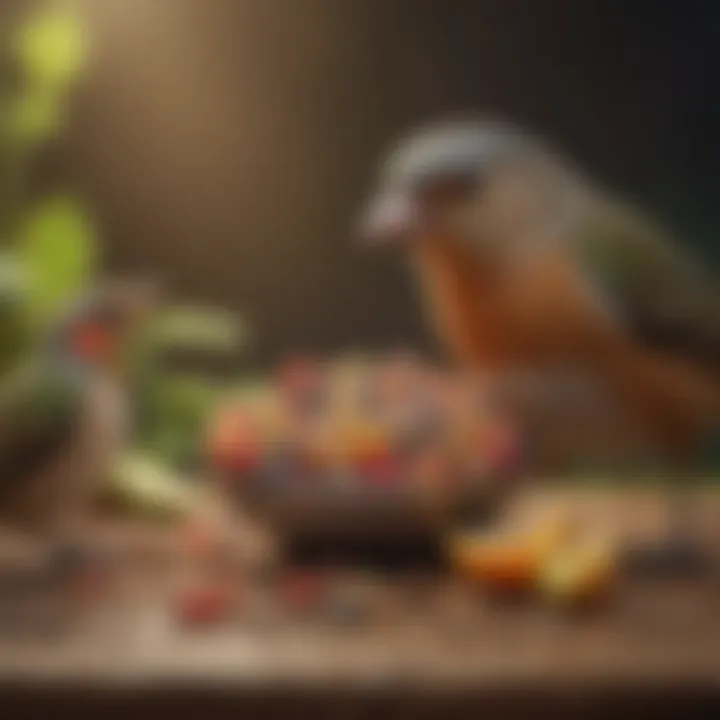Understanding the Bond with Pet Songbirds


Intro
The bond between humans and their pet songbirds goes beyond mere companionship; it forms a unique relationship that enriches both lives. These feathered musicians bring a symphony of sounds into our homes, providing not just melody but also a window into the complexities of their behavior and care needs. To fully appreciate the joy these creatures offer, one must delve deep into understanding their characteristics, habits, and specific requirements. This guide is set to illuminate the world of pet songbirds, providing valuable insights whether you are a seasoned bird enthusiast or pondering your first feathered friend.
Pet Care and Grooming
Caring for a songbird is a fulfilling journey that requires dedication and knowledge. It’s vital to recognize that regular care is not just a routine; it’s an essential part of ensuring your songbird thrives.
Importance of Regular Care
Like any pet, songbirds require a clean and safe environment. Maintaining cleanliness in their cages not only provides a healthy space but also prevents potential illnesses. A happy bird is a clean bird, and prioritizing this aspect can lead to a more vibrant companion.
Grooming Techniques by Pet Type
Different songbird species have varied grooming needs. For example, canaries and finches generally don't require professional grooming but need their nails checked periodically. A simple trim might be all they need. Parakeets, on the other hand, benefit from regular baths which can be done with a shallow dish of water or gentle misting.
Tools and Products Recommendations
Investing in the right tools can make a considerable difference in your pet bird's health. Look for:
- Perches: Ensure they are of varying widths to promote foot health.
- Cage Liners: Easy to change and help reduce mess.
- Bird Bath: A small bowl or a spray bottle for baths.
Seasonal Care Tips
As the seasons change, so do the requirements for your songbird. During winter, make sure their environment remains warm and draft-free. It's equally important to provide fresh bathing options during warmer months.
"Regular care not only keeps your pet healthy but also builds trust, ensuring a stronger bond."
Health and Nutrition
Understanding the nutritional needs of songbirds is the cornerstone of their well-being. Each species has distinct dietary requirements that need careful consideration.
Understanding Pet Nutrition
Quality seed blends, fresh fruits, and vegetables are fundamental to a balanced diet. For many small birds, seeds alone cannot provide all the essential nutrients necessary for optimal health.
Common Health Issues by Species
Different species are prone to specific health issues. For example, budgerigars are known for feather plucking due to stress, while cockatiels can suffer from fatty liver disease if overfed high-fat seeds. Recognizing these troubles early can lead to effective treatment.
Preventive Care and Regular Check-Ups
Regular vet visits are crucial. A well bird, just like any other pet, benefits from an annual check-up. Keeping vaccinations and health screenings on a schedule can help catch potential issues before they escalate.
Food and Dietary Advice
Incorporate a variety of foods to keep your songbird interested in eating. Offer small amounts of veggies like spinach or carrots; avoid feeding avocados, as they can be toxic to birds.
Behavioral Training
Songbirds are intelligent creatures, and understanding their behavior is essential for harmonious living.
Basics of Positive Reinforcement
Using treats to reward good behavior is an effective training method. It fosters trust and encourages your bird to repeat desirable actions.
Training Techniques Users Can Apply
Start with simple commands and gradually increase complexity. Repetition and consistency are key. For example, teaching your bird to step up onto your finger can lay the groundwork for more advanced commands.
Managing Behavioral Issues
Boredom can lead to destructive behavior. Regular interaction and mental challenges are pivotal in keeping your bird amused. If a specific behavior becomes a problem, identify triggers and adjust the environment or routine.
Importance of Socialization
Songbirds are social animals. Regular interaction with humans as well as with other birds when possible can significantly reduce stress and enhance their quality of life.
Engaging Activities and Enrichment
It's important to provide stimulating activities for your songbird to enjoy.
Fun Games to Play with Your Pet
Simple games like look-and-fetch can spark interest. Try tossing a soft ball or toy and encouraging your bird to retrieve it.
DIY Toys and Activities
Use household items to create enriching toys. For instance, tissue paper can be tucked into a small cardboard box to stimulate the bird's natural foraging behavior.
Importance of Mental Stimulation
Offer challenges like puzzle feeders that dispense food. These engage your pet's mind and keep boredom at bay.
Outdoor Adventures and Exploration


If your bird is comfortable with it, consider supervised outdoor visits in a flight-safe harness or aviary. Fresh air and natural sunlight can significantly uplift their spirits.
Resources and Community Engagement
Engaging with the community can deepen your appreciation and understanding of songbirds.
Recommended Books and Websites
Explore resources like Birds of North America and visit websites like Wikipedia for reliable information.
Forums and Groups for Pet Owners
Platforms such as Reddit or Facebook groups focused on birds are great for sharing experiences with fellow enthusiasts.
Finding Local Services and Classes
Check community boards for training classes and local avian vets. Connecting with professionals can help refine your bird care skills.
Encouraging Community Sharing and Contributions
Consider starting or joining a community blog where pet owners share their stories and tips. It can be enriching to learn from the experiences of others.
The journey of caring for a songbird is one filled with discovery and joy. By fostering an environment that emphasizes understanding, care, and enrichment, pet owners can experience the true beauty of companion birds.
Understanding Pet Songbirds
Pet songbirds hold a special place in many households, often regarded as delightful companions that enrich our lives with their enchanting melodies. Understanding these charming creatures can lay the foundation for a rewarding relationship between birds and their owners. It’s essential to recognize various aspects, including their habits, needs, and characteristics, that affect both the birds' well-being and the owner’s experience.
On the surface, songbirds may seem like simple pets, but their requirements and behaviors are intricate, demanding closer attention. When we delve into their world, it becomes clear that these birds are not just colorful ornaments for our homes; they bring with them a vibrant spectrum of sounds and personalities.
Pet songbirds can reduce stress, promote relaxation, and even encourage social interaction among family members. Owners often find joy in teaching their birds to vocalize, creating bonds that transcend mere caregiving. By understanding their habitats and social needs, pet owners can set the stage for thriving companionship, ensuring that their feathered friends remain happy and healthy.
Defining Pet Songbirds
Pet songbirds can be broadly defined as small birds known for their melodious singing abilities, predominantly kept as companions. These include a wide array of species from tropical finches to the well-loved canaries. Each type of songbird exhibits unique vocalizations, which tend to vary greatly, often reflecting their individual personalities. Some pet songbirds are particularly prized for their impressive singing capabilities; for instance, the American canary is renowned for its varied and delightful songs.
Songbirds usually have adaptable temperaments. While many enjoy mingling with humans, others might be more independent, thriving on their own. Optimal care requires an understanding of these various traits. Pet songbirds can be classified based on general categories, including canaries, finches, budgerigars, and cockatiels—each bringing its own flair to the repertoire of avian charm.
A Brief History of Songbirds as Pets
Throughout history, songbirds have bewitched people across cultures and continents. Their journey from wild creatures to cherished pets is quite fascinating. Initially, these birds were admired in the wild for their beautiful songs and stunning appearances. It’s widely believed that the domestication of songbirds began in ancient China, around 2000 years ago, where people recognized their charm and beauty.
In Europe, during the 16th and 17th centuries, the popularity of songbirds surged among nobility. Canaries, in particular, became fashionable, often gifted among the upper class as symbols of status and sophistication. These birds were not only kept for their songs but also bred selectively to develop different color mutations.
As time went on, the practice of keeping songbirds spread, making its way into the homes of common folk. With the advent of modern breeding techniques, various species became accessible to a broader array of enthusiasts, and they continue to capture the hearts of many today.
"Songbirds transform a house into a home, their melodies turning silence into sweet music.”
Understanding the history and significance of pet songbirds adds depth to their role in our lives. Their songs have reached beyond mere entertainment, fostering a deeper connection with nature itself, which has never failed to resonate with people of all backgrounds.
Popular Species of Pet Songbirds
When it comes to bringing a bit of nature indoors, pet songbirds are quite the catch. Each species comes with unique traits, vocalizations, and care requirements that can fit various lifestyles and environments. Understanding popular species of pet songbirds not only helps prospective bird owners make educated decisions, but it also enhances the overall joy that these chirpy companions bring into our lives.
Canaries
Canaries are often the first birds that come to mind when people think about songbirds. Known for their melodious singing, these little avians come in many colors and varieties—most notably the American Singer and the Yorkshire Canaries. They are generally easy to care for as they thrive on a simple diet of seeds supplemented with fresh fruits and vegetables. Their charming tunes are a treat, but it’s important to note that unlike some other species, male canaries are the only ones that sing consistently.
What’s fascinating about canaries is how they react to their environment. A canary’s singing can serve as an indicator of its wellbeing; when it’s happy, it’ll sing its heart out, while signs of distress may lead to silence or even unusual behavior. Providing a warm, quiet space will typically keep a canary in good spirits.
Finches
Finches are colorful, active little birds that love to socialize—not only with their owners but also among each other. These birds can fit into nearly any living space, as they don’t require the same level of interaction as some other species. Some popular types are the Zebra Finch and the Gouldian Finch, each boasting distinct colors and patterns that brighten any home.
In terms of care, finches thrive in pairs or small groups, and watching them interact can be delightful. However, they don't typically sing like canaries. Instead, they produce a series of cheeps and whistles. Their diet usually consists of seed mixes, but adding greens and insects can keep them in prime condition. If you notice your finch becoming withdrawn, it may require more social interaction or a bigger living space.
Budgerigars
Budgerigars, often affectionately known as budgies, are one of the most popular pet birds worldwide. These intelligent and friendly parrots come in various colors, from the typical green to vibrant blues and yellows. Unlike canaries, both male and female budgies can learn to mimic sounds and even speak. Their playful nature means they require a good amount of mental stimulation, so toys and social interaction are crucial.
Feeding them is relatively simple, with a foundational diet of high-quality pellets and seeds, complemented by fresh fruits and vegetables. Budgies enjoy company, so if you're considering adopting one, you might want to think about getting a pair or ensuring they have ample interaction with you or other birds. Their vocal chatter can be both amusing and harmonious when properly nurtured.
Cockatiels
Cockatiels are known for their affectionate nature and distinct crest on their heads. They are friendly birds that often bond closely with their owners, making them ideal for those looking for companionship. Their soothing whistles and ability to mimic sounds make them a popular choice for many bird enthusiasts.
Care for a cockatiel is straightforward; they thrive on a diet rich in seeds, grains, and fresh produce. Regular interaction is crucial for their emotional health—without it, they can become bored or stressed. Signs of stress may show through excessive preening or changes in their singing. Regular playtime out of their cage is essential to keep them entertained and happy.
"Choosing the right species can enhance your experience as a pet owner and enrich your living space with melodies and companionship."
In summary, selecting a pet songbird requires thoughtful consideration of their unique traits and care needs. Canaries, finches, budgerigars, and cockatiels each bring something distinct to the table, making the choice all the more exciting for potential bird owners.
Vocal Abilities of Songbirds
Songbirds are more than just vibrant additions to our homes; their vocal abilities serve as one of the most enchanting aspects of their companionship. From melodious morning melodies to softer nighttime chirps, their sounds create a rich tapestry of audio beauty that can uplift spirits and soothe the mind. Understanding these vocalizations not only fosters a deeper connection between humans and birds but also highlights the diverse personalities and moods these feathered friends convey. Many pet owners find joy in simply listening to their songbirds, while also appreciating the complexity of their calls and songs.


Understanding Bird Sounds
Bird sounds can be likened to a language. Each chirp, whistle, and trill has its place, meaning a variety of things. Songbirds communicate to assert territory, attract mates, or signal alarm. A canary may sing a delightful tune early in the morning, letting its owner know everything is right in its world. Conversely, a sudden, frantic squawk from a budgerigar may indicate stress or the presence of a perceived threat.
Recognizing these sounds allows owners to respond appropriately to their pets’ needs. Listening closely to your songbird increases your understanding of its daily rituals and emotional state. It’s important to understand variations in vocalization based on the species, as each one has unique characteristics. For instance:
- Canaries are renowned for their clear and melodious songs.
- Finches produce a diverse range of high-pitched calls.
- Cockatiels often mimic sounds, including human speech, showing their intelligence.
"The beauty of songbirds lies not just in their song but in the unspoken bond created through those interactions."
Training Songbirds to Sing
Just as a gardener tends to flowers, training songbirds to sing requires patience and dedication. While some birds possess innate singing abilities, others can be encouraged to develop their vocal skills through repetitive training. Setting the right environment is crucial. A quiet, peaceful setting helps them feel secure, which often prompts more vocal expression.
There are several techniques to encourage songbirds to sing more freely:
- Consistent Exposure to Music: Play recordings of their species singing. They learn by ear, and over time, may mimic these tunes.
- Positive Reinforcement: When they sing, reward them with treats or verbal praise. This reinforces their behavior and makes singing a happy event.
- Daily Interaction: Spend time near their cage, chatting and singing to them. Your voice can become part of their musical repertoire.
Be mindful, however, that not every songbird will reach the same level of vocal proficiency. Differences in personality, environment, and genetics can all play a role. Respecting these individual characteristics ensures a happier and more fulfilling experience for both you and your feathered friend.
In short, the vocal capabilities of songbirds enrich our lives in profound ways. Observing their sounds, training for vocal expression, and understanding their communication not only supports their well-being but also enhances the bond we share with these delightful companions.
Housing and Environment for Songbirds
The comfort and safety of pet songbirds largely hinge on their housing and environment. A well-thought-out living space ensures not only the physical health of these feathered companions but also their mental and emotional well-being. When choosing how to house a songbird, one must consider the size of the cage, the environment around it, and the stimulation it offers. A well-suited habitat becomes a sanctuary for songbirds, aiding in their natural behaviors and fostering a joyful existence.
Choosing the Right Cage
Selecting the ideal cage for your songbird is akin to picking a cozy home for yourself. The dimensions should allow ample room for the bird to flap its wings freely and hop around without constraint. A good rule of thumb is to aim for a cage that is at least twice the wingspan of the bird from side to side and threefold from top to bottom. Also, consider the following:
- Bar Spacing: The gaps between bars should be just right; too wide, and your bird might escape, too narrow, and it could get stuck.
- Material: Stainless steel or powder-coated metal is preferable, as they resist corrosion and are easier to clean compared to other materials.
- Shape: While traditional rectangular cages are common, round cages can provide less cornered space and more flightspace.
In addition, be sure to provide a variety of perches — both natural wood and synthetic ones — to keep their feet healthy and happy. Adorn the cage with toys that encourage exploration and mental stimulation, which helps to keep the feathered friend engaged. A well-chosen cage can dramatically improve a songbird’s quality of life.
Environmental Enhancements for Songbirds
Going beyond the cage itself, creating a fulfilling environment for pet songbirds can lead to a richer, more vibrant life. This involves considering both the immediate space of the cage as well as the surrounding area. Here are some ideas to enhance the environment:
- Natural Light: Positioning the cage near a window can provide beneficial sunlight. Just ensure it’s not in direct hot sunlight for extended periods.
- Seasonal Decorations: Changing the decor according to seasons not only keeps the visual engaging but also mimics the natural shifts songbirds experience in their wild habitats.
- Indoor Plants: Incorporate non-toxic plants or hanging vines around the cage. This addition can enhance air quality and provide birds with interesting sights.
- Bath Areas: Place shallow dishes of water for baths or misting. Songbirds, like canaries, enjoy splashing around, and it helps keep their feathers in top condition.
- Noise Control: Giving birds a quieter living area can be beneficial. Too much commotion from loud noises can induce stress, making them more anxious.
"An enriched environment gives them not just a living area but an experience that parallels their instincts and behaviors in the wild."
These enhancements contribute to the overall happiness of songbirds. The right mix of housing and environmental considerations plays a significant role in their overall health and can greatly influence their behavior and vocalizations, contributing to a harmonious household free of stress.
Feeding and Nutrition
Feeding and nutrition are critical components in the overall well-being of pet songbirds. An optimal diet is not just about keeping them full; it significantly impacts their health, lifespan, and even singing abilities. Understanding the unique nutritional needs of different species ensures that you provide a supportive environment for your feathery friends. Let's delve into the essentials of a balanced diet and highlight common dietary mistakes that pet owners might encounter.
Essentials of a Balanced Diet
A balanced diet for songbirds must include a variety of nutrients necessary to maintain their health and vitality. Here are the primary components:
- Seeds and Grains: While many songbirds love seeds, it's crucial to offer a mix that avoids excessive fat intake. For instance, a blend of canary seed, millet, and oat groats works well. However, seeds should not take up their entire diet.
- Fruits and Vegetables: Fresh produce is vital. Fruits such as apples, berries, and veggies like spinach or carrots provide essential vitamins and minerals. Chopping them into small, manageable pieces can encourage your bird to try them.
- Pellets: High-quality bird pellets are an excellent way to ensure that your pet gets a nutritionally complete diet. Pellets are fortified with necessary vitamins and can prevent selective eating.
- Protein Sources: Depending on the species, protein is also needed. Options like boiled eggs, mealworms, or specialized bird food can supplement their diet, bringing a balance.
Regularly varying these components maintains interest in meals and ensures that your pet is not just eating for survival but rather thriving. Remember to introduce new foods slowly to prevent digestive issues.
Common Dietary Mistakes
Even experienced pet owners can make mistakes when it comes to feeding songbirds. Here are some pitfalls to avoid:
- Overfeeding Seeds: Seeds are often a favorite, but relying too heavily on them can lead to obesity and nutritional deficiencies. Limit their quantity and ratio in your bird's daily meals.
- Neglecting Fresh Food: Many owners may underestimate the importance of fresh fruits and vegetables. Stale or dried foods can lose their nutritional value over time, so always provide fresh options.
- Ignoring Species Specificity: Different species have different dietary needs. Budgerigars, for example, require a varied diet much different from that of canaries. Make sure to research your bird's specific requirements.
- Not Providing Clean Water: Hydration is crucial. Always offer fresh, clean water. Change it daily to prevent bacteria and algae, which can lead to health issues.
"The health of your bird hinges on what you offer in its bowl. Pay attention to that, and you will see the rewards in your pet’s happiness and vitality."
By understanding these essentials and avoiding common mistakes, you can ensure your songbirds receive the right nutrition to thrive in their environment. A well-fed bird not only sings better but also exhibits a lively personality, adding joy to your home.
Health Care Considerations
Taking care of a pet songbird goes beyond providing food and a cage. Like any other pet, songbirds need proper health care to thrive. This topic is fundamental for all pet owners, as it touches upon how to maintain your bird's health and well-being throughout their life. The importance of health care considerations lies in both prevention and early detection of potential issues, which ultimately leads to happier, more active birds.
Pet songbirds, just like dogs and cats, can be prone to a range of health problems. Regular veterinary checks allow owners to catch any concealed illnesses before they become severe. The bond that develops through consistent interaction, including health-related checks, strengthens the relationship, making your bond with your songbird even deeper.
Regular Health Checks
Performing routine health checks on your songbird is not just about being a responsible pet owner; it's an investment in the bird's quality of life. These checks can be conducted through various means:
- Visual Inspections: Look for signs of distress such as unusual feather loss, abnormal droppings, or labored breathing.
- Behavioral Changes: Note any shifts in your bird’s eating habits or activity levels. Is your once chatty companion suddenly quiet?
- Changing Environment: Make sure their environment remains consistent; stressors from loud noises, new animals, or even changing routines can affect their health.
Regular visits to an avian vet can also be crucial. They will check for parasites, infections, and even nutritional deficiencies, making recommendations as necessary. Most importantly, a vet can administer any needed vaccinations to prevent potential outbreaks of infectious diseases. As the old saying goes, "an ounce of prevention is worth a pound of cure."
Common Health Issues
As with all pets, songbirds face particular health challenges. Familiarizing yourself with the common issues can help you act swiftly if your bird gets sick. Here are some ailments to watch for:
- Respiratory Infections: This can manifest in wheezing or sneezing. Overcrowded cages can be breeding grounds for airborne pathogens.
- Obesity: Overfeeding or lack of activity can lead to weight problems, which significantly affect a bird's mobility and lifespan.
- Psittacosis: A serious bacterial infection that can make birds very ill. Symptoms include lethargy and difficulty breathing.
- Feather Disorders: Molting can be a cause for concern if it becomes excessive, possibly resulting from stress or poor nutrition.


"An informed pet owner is the best defense against potential health issues."
Addressing these conditions early can mean the difference between a short-lived pet and a vibrant songbird companion who fills your home with music for years. Consult with your veterinarian for tailored advice specific to your species of songbird, because these birds are not just pets; they are living beings that require our full attention and care. When their health is prioritized, you ensure their happiness and well-being, which in turn enriches your life as well.
Behavioral Traits of Songbirds
Understanding the behavioral traits of songbirds is paramount when it comes to their care and interaction. These traits not only influence how they relate to their environment but also speak volumes about their wellbeing and happiness. Observing these behaviors allows pet owners to foster a supportive, enriching habitat that caters to the needs of their feathered friends while deepening the human-bird bond.
Songbirds are social creatures by nature, and their interactions with other birds—whether they are species-specific or among different types—play a significant role in their mental stimulation. Well-socialized songbirds can be more vocal and exhibit fewer stress behaviors compared to those kept in isolation. Thus, understanding their social context can greatly enhance their quality of life.
Understanding Social Interactions
Delving into the social life of songbirds reveals a series of intriguing patterns. Social interactions aren't just about companionship. They are crucial for communication, asserting dominance, and establishing a pecking order within a group. Observing how your songbird interacts with others can offer insight into their comfort level and potential issues.
- Playful Behavior: Birds may engage in playful antics, flying around or chasing each other. This can be a sign of a healthy, active environment.
- Vocalizations: The way songbirds communicate amongst themselves varies widely; each chirp or tweet might be a message, from warning calls to mating songs. Keeping note of these sounds can help you interpret their mood and desires.
- Grooming: Mutual grooming is another way songbirds bond. It not only helps maintain their feathers but also strengthens social ties. If you notice your bird preening another, it’s a positive indicator of social comfort.
Identifying Stress Signals
Just like humans, songbirds express their emotions, including stress, in various ways. Recognizing these signals is essential for providing a nurturing environment.
Signs of stress can include:
- Excessive Vocalizations: If your usually talkative songbird becomes unusually quiet or suddenly starts screeching, it may be responding to stressors in its environment.
- Feather Plucking: A bird that starts removing its feathers is likely experiencing significant stress. This can be triggered by loneliness or an unfulfilling habitat.
- Aggression Towards Others: If a songbird begins to show aggression—such as chasing or biting—it may feel threatened, either by rivals or a human presence.
- Changes in Eating Habits: A sudden decrease in appetite or over-eating can indicate that a bird is not feeling secure or healthy.
"Understanding your pet's behaviors is key to fostering well-being and joy in their world."
When you can identify these stress signals, you gain the ability to alleviate your bird’s discomfort. Adjustments such as enriching the habitat, introducing companionship, or even revising your interaction methods can make a world of difference. Ultimately, the more aware you are of your songbird's behavioral nuances, the better you can respond to their needs, resulting in a happier, more harmonious life for both the bird and its owner.
Enhancing the Bond with Pet Songbirds
Building a strong connection with pet songbirds is essential for their well-being and for creating a fulfilling relationship between the bird and its owner. Engagement, understanding, and interaction are crucial elements that contribute to this bond. Through these aspects, pet owners can foster a more harmonious environment, which not only enhances the happiness of the songbird but also the joy and satisfaction of the owner.
Birds, being inherently social creatures, require stimulation and companionship. Nurturing this bond can greatly improve their mental health, encourage vocalization, and reduce stress or boredom. More than just pets, songbirds become integral parts of the family dynamic, bringing unique interactions and lessons into everyday life.
Engaging Activities for Interaction
Creating opportunities for interaction with songbirds is vital. Simple routines can turn mundane care into cherished moments. Here are a few activities to enhance the interaction:
- Singing Along: Most songbirds enjoy mimicking sounds. Singing or whistling can encourage them to join in, creating a playful duet. Not only does this stimulate their vocal skills, but it also forms a social engagement that reinforces the bond.
- Toys and Enrichment: Providing various toys that promote foraging and problem-solving can keep songbirds entertained. Hanging mirrors or colorful objects can attract their curiosity, making them more likely to interact. Consider using items that require them to move and play, as this encourages physical activity too.
- Out-of-Cage Time: Allowing birds some time outside their cage can be enriching. Supervised exploration around a safe room, with secure perches, provides them with spaces to feel more at home and adventurous. Just ensure that the environment is safe and free from hazards.
- Training Sessions: Engaging in short training sessions using positive reinforcement techniques can be both fun and educational. Rewarding your songbird for mimicking sounds or completing simple tricks enhances their cognitive abilities while strengthening the relationship.
Engagement needs to be consistent and varied. When songbirds perceive active involvement from their owners, their emotional and social needs are better met, leading to a more bonded relationship.
Understanding Bird Body Language
Understanding how songbirds communicate through body language is essential for strengthening the bond. Unlike humans, birds do not rely solely on vocalizations; their physical movements convey a wealth of emotions and intentions. Here are some common body language cues:
- Tail Positioning: A bird's tail can tell a lot. An upright position often signifies excitement or curiosity, while a drooping tail may indicate fear or stress.
- Feather Ruffling: If a songbird ruffles its feathers, it can indicate relaxation, similar to how humans might stretch. However, persistent ruffling might point to anxiety or discomfort.
- Eye Pinning: Observing the rapid dilation and constriction of the pupils can be a sign of excitement or agitation. Knowing when to engage or give space is crucial based on this signal.
- Posture Changes: A relaxed, open posture often means your bird is feeling safe and secure, while a crouched position can indicate fear or threat.
Being attuned to these signals allows owners to respond appropriately to the needs of their songbirds, fostering trust and a deeper bond. Through patience and understanding, pet owners can create connections that transcend simple pet ownership, turning it into a mutually enriching experience.
Remember, songbirds can be sensitive. Taking the time to learn their body language not only improves interaction but also enriches both your life and theirs significantly.
The Educational Value of Owning Songbirds
Owning songbirds can be an enlightening experience, enriching not just the lives of the birds but also the lives of their human companions. When individuals choose to share their homes with these avian creatures, they embark on a unique journey filled with numerous learning opportunities. The educational value extends well beyond just learning how to care for them. It dives into understanding their intricate behaviors, their roles within the ecosystem, and the responsibility that comes with being a pet owner.
Learning About Avian Behavior
Understanding avian behavior is akin to unlocking a door to a fascinating world. Each species of songbird exhibits distinct characteristics. For instance, the social butterflies like the budgerigar thrive in flocks and often display playful antics, while solitary species such as canaries may prefer moments of introspection. By observing these behaviors, owners can gain insight into what makes each bird unique.
Over time, pet owners develop skills in recognizing birds' emotional cues and needs, which is crucial in fostering a strong bond between human and bird. This also cultivates patience and empathy as owners learn to respect their pet's signals—whether it's a note of delight or signs of distress.
Some educational highlights include:
- Training Basics: Many songbirds can be trained through positive reinforcement, offering lessons in animal psychology.
- Understanding Social Dynamics: Observing interactions among different species or even between birds and humans reveals much about social structures and hierarchies.
- Behavioral Research: Keeping songbirds can spur curiosity about avian biology, encouraging deeper exploration into their natural habitats, migratory patterns, and life cycles.
"Understanding your songbird’s behaviors not only enhances your connection but also contributes to a fulfilling life for both the pet and the owner."
The Role of Songbirds in Biodiversity
Songbirds play a pivotal role in maintaining biodiversity. They are not just delightful companions; they also serve vital functions in our ecosystems. These birds contribute to pollination and seed dispersal—actions that are essential for healthy plant life. As pet owners delve into the ecological roles of songbirds, they develop a greater appreciation for nature’s interconnectedness.
Moreover, learning about species that are at risk of extinction fosters an understanding of conservation efforts. Owners can become advocates for protecting their feathered friends' natural habitats in the wild, thus contributing to broader biodiversity initiatives. Here are a few points underlining their significance:
- Ecosystem Balance: Songbirds help control insect populations, facilitating a healthier balance in nature.
- Indication of Environmental Health: The presence or absence of certain songbird species can signal changes in local ecosystems, providing insight into the health of the environment.
- Community Awareness: Through discussions and shared experiences, songbird ownership can elevate awareness about the importance of biodiversity within communities.
The educational benefits of owning songbirds extend beyond practical knowledge; they encompass a profound appreciation for life itself. Engaging with these remarkable birds leads to lifelong learning and a deep commitment to understanding not just songbirds, but the planet we share with them.
Closure
As we conclude our exploration of pet songbirds, it’s evident that these creatures bring a unique blend of joy and complexity to their owners' lives. Understanding the relationship we cultivate with these feathered companions is paramount, not only for their welfare but also for enhancing our own experiences. The delight they provide through song and the various lessons in responsibility and care they impart to us are invaluable.
Reflecting on the Joy of Songbirds
One of the most fulfilling aspects of having pet songbirds is witnessing their personalities unfold. Each bird has its own character, from the cheerful trill of a canary to the playful chatter of a budgerigar. These vocal marvels are not just pets; they become integral members of our households, providing companionship and entertainment.
Their songs can transform an ordinary day into something remarkable. Just imagine sitting in your living room, while a cockatiel bursts into song, filling the space with its melodious notes. Moments like this aren’t just about the sound; they resonate with a sense of peace and joy that enhances our well-being. Studies suggest that the presence of pets, including songbirds, can reduce stress and elevate mood.
Moreover, caring for songbirds offers profound educational value. As pet owners, we delve into their needs—how to create the perfect environment, what to feed them, and recognizing their social behaviors. This journey fosters not only a greater appreciation for avian life but also builds empathy and patience.
Songbirds, in essence, teach us about the delicate balance of nature and the importance of stewardship. They remind us that every creature has its place and role in the ecosystem, encouraging us to consider our responsibilities as caretakers.
In summary, owning a pet songbird is more than just a hobby; it's an enriching experience that leaves a lasting impact on both the owner and the bird. The joy they bring is often profound, transforming our daily routines and reinforcing the bonds of companionship. As we reflect on the myriad ways songbirds enrich our lives, it becomes clear that embracing these avian companions is an opportunity not to be missed.















